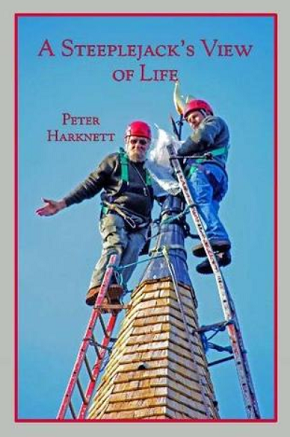A Steeplejack's View of Life

|
| A Steeplejack’s View of Life, Peter Harknett, Steeplejack Publishing, 2018, 176 pages hardback, fully illustrated. |
Those who spend 50 or more years in their chosen job deserve a salute and probably have something worthwhile to pass on. Peter Harknett began his way up the ladder of success after National Service in the 1950s and he tells us he is still enjoying life at the top in his eighties. He passes on his considerable knowledge amusingly in this well-produced book, packed with valuable information in its 19 chapters.
The Federation of Master Steeplejacks was formed in 1948. The author began to learn about working at heights soon after this, when employed as a rigger on circus tents. He then began touring the country knocking on doors or ‘repping’ for work on church spires, Victorian school roofs and industrial chimneys that required repair or demolition. Little by little he became established and he has worked as far away as Israel.
Apart from the many hilarious incidents and scary adventures that he recounts with such grace, and sometimes illuminates with his own black-and-white sketches, the book is rich in tips that most readers in all aspects of our business will find of great use. Shingles are widely employed to clad church towers or spires, but Harknett takes us deep into the topic from the origins, sources, roles in woodpecker diet, and ultimate replacement of these wooden tiles. Chapter 14, ‘To shingle a spire’ is a model method statement of every aspect of such a task.
The book arrived with the mail only a couple of days after news of the disaster at Notre Dame, Paris. Despite some close scrapes, the author reports on numerous similar jobs on which he worked, but neither life nor fabric have suffered loss. Church authorities, architects and all those involved in the administration of the potentially hazardous matter of replacing or repairing roofs, bells, clocks or weathervanes are advised to read and learn from the wisdom and experience imparted.
This article originally appeared as 'Life at the top' in IHBC's Context 160 (Page 50), published by The Institute of Historic Building Conservation in July 2019. It was written by Graham Tite, conservation officer.
--Institute of Historic Building Conservation
Related articles on Designing Buildings Wiki
IHBC NewsBlog
Purcell’s guidance on RAAC for Listed Buildings in England & Wales
The guidance specifically focuses on Reinforced Autoclaved Aerated Concrete (RAAC) in listed buildings.
IHBC Membership Journal Context - Latest Issue on 'Hadrian's Wall' Published
The issue includes takes on the wall 'end-to-end' including 'the man who saved it'.
Heritage Building Retrofit Toolkit developed by City of London and Purcell
The toolkit is designed to provide clear and actionable guidance for owners, occupiers and caretakers of historic and listed buildings.
70 countries sign Declaration de Chaillot at Buildings & Climate Global Forum
The declaration is a foundational document enabling progress towards a ‘rapid, fair, and effective transition of the buildings sector’
Bookings open for IHBC Annual School 12-15 June 2024
Theme: Place and Building Care - Finance, Policy and People in Conservation Practice
Rare Sliding Canal Bridge in the UK gets a Major Update
A moveable rail bridge over the Stainforth and Keadby Canal in the Midlands in England has been completely overhauled.
'Restoration and Renewal: Developing the strategic case' Published
The House of Commons Library has published the research briefing, outlining the different options for the Palace of Westminster.
Brum’s Broad Street skyscraper plans approved with unusual rule for residents
A report by a council officer says that the development would provide for a mix of accommodation in a ‘high quality, secure environment...
English Housing Survey 2022 to 2023
Initial findings from the English Housing Survey 2022 to 2023 have been published.
Audit Wales research report: Sustainable development?
A new report from Audit Wales examines how Welsh Councils are supporting repurposing and regeneration of vacant properties and brownfield sites.
















